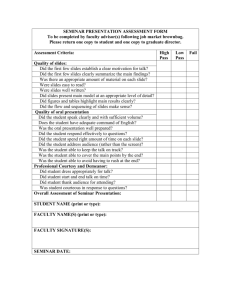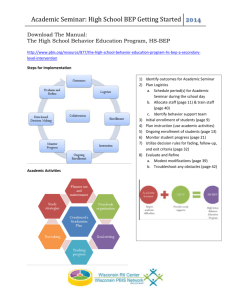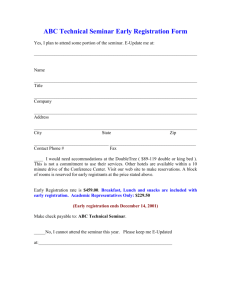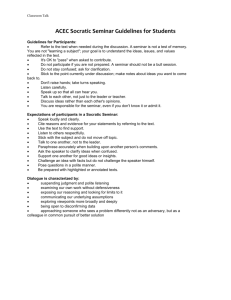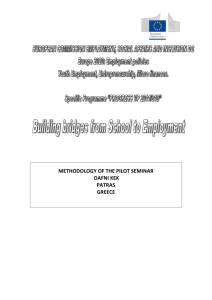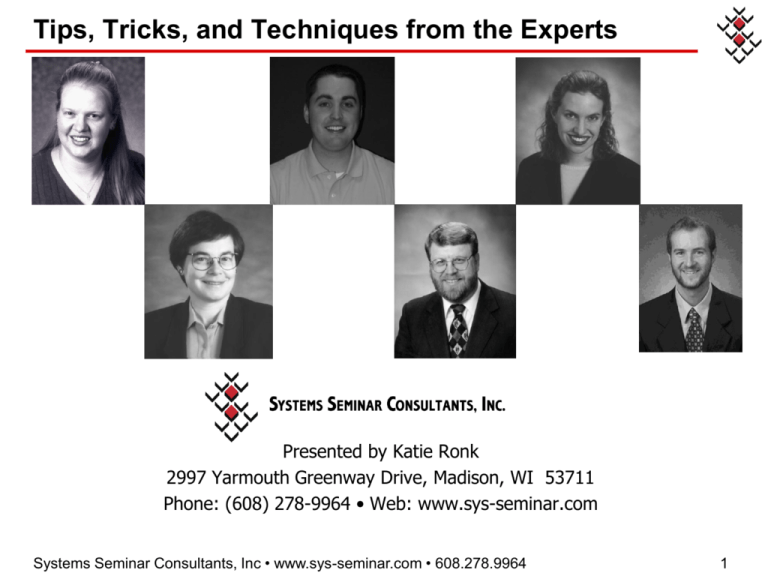
Tips, Tricks, and Techniques from the Experts
Presented by Katie Ronk
2997 Yarmouth Greenway Drive, Madison, WI 53711
Phone: (608) 278-9964 • Web: www.sys-seminar.com
Systems Seminar Consultants, Inc • www.sys-seminar.com • 608.278.9964
1
Tips, Tricks, and Techniques from the Experts
This paper was written by Systems Seminar Consultants, Inc.
SSC specializes in SAS software and offers:
• Training Services
• Consulting Services
• Help Desk Plans
• Newsletter Subscriptions to The Missing Semicolon™
COPYRIGHT© 2004 Systems Seminar Consultants, Inc.
All rights reserved. Printed in the United States of America. No part of this
publication may be reproduced, stored in a retrieval system, or
transmitted, in any form or by any means, electronic, mechanical,
photocopying, or otherwise, without prior written permission of SSC. SAS
is a registered trademark of SAS Institute Inc. in the USA and other
countries. The Missing Semicolon is a trademark of Systems Seminar
Consultants, Inc.
Systems Seminar Consultants, Inc • www.sys-seminar.com • 608.278.9964
2
Tips, Tricks, and Techniques from the Experts
• TIPS
•
•
TRICKS
TECHNIQUES
Back issues on website: www.sys-seminar.com
Systems Seminar Consultants, Inc • www.sys-seminar.com • 608.278.9964
3
Tips, Tricks, and Techniques from the Experts
•
•
•
•
•
DATA Step
PROC Step
Graphing
Report Formatting
Miscellaneous
Systems Seminar Consultants, Inc • www.sys-seminar.com • 608.278.9964
4
Data Step Tip: Input @ ‘TEXT’ (June 1998)
Using INPUT @ ' text' positions the input pointer directly
after the word 'text'.
DATA NAMES;
LENGTH NAME CITY $10;
INPUT @1 NAME
@ 'CITY=' CITY;
DATALINES;
KATIE CITY=MADISON
TERESA CITY=MCFARLAND
STEVE CITY=MONONA
ANN CITY=WAUNAKEE
;
RUN;
PROC PRINT DATA=NAMES;
RUN;
Systems Seminar Consultants, Inc • www.sys-seminar.com • 608.278.9964
5
Data Step Tip: Input @ ‘TEXT’ (Jun ‘98)
Output:
Obs
1
2
3
4
NAME
CITY
KATIE
TERESA
STEVE
ANN
MADISON
MCFARLAND
MONONA
WAUNAKEE
• If the text is not found, the pointer will go to a new line.
Systems Seminar Consultants, Inc • www.sys-seminar.com • 608.278.9964
6
Data Step Tip: Trailing @ For Efficiency (Oct ‘98)
Use the trailing "@" with input statements to avoid
inputting records you wish to eliminate.
Instead of:
DATA MIDWEST;
INFILE ACCOUNTS;
INPUT @1 NAME $19.
@20 STATE $2.
@24 ACCTNBR $10.
@35 BALANCE 8.;
IF STATE IN (‘WI’,’MN’,’IA’);
RUN;
Systems Seminar Consultants, Inc • www.sys-seminar.com • 608.278.9964
7
Data Step Tip: Trailing @ For Efficiency (Oct ‘98)
Better:
DATA MIDWEST;
INFILE ACCOUNTS;
INPUT @20 STATE $2. @;
IF STATE IN (‘WI’,’MN’,’IA’) THEN
INPUT @1 NAME $19.
@24 ACCTNBR $10.
@35 BALANCE 8.;
RUN;
• More Efficient
• Different Layouts in One File
Systems Seminar Consultants, Inc • www.sys-seminar.com • 608.278.9964
8
Data Step Tip: ATTRIB statement (Feb ‘99)
Use the ATTRIB statement in the Data Step to associate a
format, informat, label, and length with a variable all at
once.
Example:
ATTRIB NAME LENGTH=$20 FORMAT=$20. LABEL= "EMPLOYEE NAME";
Systems Seminar Consultants, Inc • www.sys-seminar.com • 608.278.9964
9
Data Step Tip: Alignment Option (Feb ‘99)
An alignment specification can be coded in the PUT
statement. Code -L, -C, or -R after the format.
Example:
124
125
126
127
DATA _NULL_;
SET NAMES;
PUT @1 NAME $30. -C;
RUN;
KATIE
TERESA
STEVE
ANN
NOTE: There were 4 observations read from the data set WORK.NAMES.
Systems Seminar Consultants, Inc • www.sys-seminar.com • 608.278.9964
10
Data Step Tip: FIRSTOBS Option (Oct ‘99)
When reading raw files use the FIRSTOBS=record-number
to begin reading the input data at the record number
specified.
This is also helpful when you don’t want to read a header
record, usually stored in the first record of the input file.
Example:
INFILE RAWFILE FIRSTOBS=2;
Systems Seminar Consultants, Inc • www.sys-seminar.com • 608.278.9964
11
Data Step Tip: FIRSTOBS & OBS Options (Oct ‘99)
To read a range of records from a raw file you can use the
FIRSTOBS option combined with OBS=record-number,
where record-number specifies the last record that you
want to read from an input file.
Example:
INFILE RAWFILE FIRSTOBS=10 OBS=30;
Results in 21 records being read, 10 through 30.
Systems Seminar Consultants, Inc • www.sys-seminar.com • 608.278.9964
12
Data Step Tip: Adding Variables with Formats
(Jan ‘00)
A format can be used instead of a join to add a variable.
Example:
Enrollment Dataset:
Obs
1
2
3
4
NAME
KATIE
TERESA
STEVE
ANN
ENRDATE
17SEP2002
17OCT2000
01MAY1998
13AUG2001
PLAN
A
A
B
B
City Dataset:
Obs
1
2
3
4
NAME
KATIE
TERESA
STEVE
ANN
CITY
MADISON
MCFARLAND
MONONA
WAUNAKEE
Systems Seminar Consultants, Inc • www.sys-seminar.com • 608.278.9964
13
Data Step Tip: Adding Variables with Formats
Create a User Defined Format from the data:
DATA CITYFMT;
SET CITY;
RETAIN FMTNAME '$CITYFMT';
RENAME NAME=START
CITY=LABEL;
RUN;
PROC FORMAT CNTLIN=CITYFMT; RUN;
PROC PRINT DATA=CITYFMT; RUN;
Obs
1
2
3
4
START
LABEL
FMTNAME
KATIE
TERESA
STEVE
ANN
MADISON
MCFARLAND
MONONA
WAUNAKEE
$CITYFMT
$CITYFMT
$CITYFMT
$CITYFMT
Systems Seminar Consultants, Inc • www.sys-seminar.com • 608.278.9964
14
Data Step Tip: Adding Variables with Formats
Create a User Defined Format from the data:
Obs
1
2
3
4
START
LABEL
FMTNAME
KATIE
TERESA
STEVE
ANN
MADISON
MCFARLAND
MONONA
WAUNAKEE
$CITYFMT
$CITYFMT
$CITYFMT
$CITYFMT
Equivalent to:
PROC FORMAT;
VALUE $CITYFMT
‘KATIE’ =‘MADISON’
‘TERESA’=‘MCFARLAND’
‘STEVE’ =‘MONONA’
‘ANN’
=‘WAUNAKEE’;
RUN;
Systems Seminar Consultants, Inc • www.sys-seminar.com • 608.278.9964
15
Data Step Tip: Adding Variables with Formats
Apply the User Defined Format:
DATA EMP;
SET ENROLLMENT;
CITY=PUT(NAME,$CITYFMT.);
RUN;
PROC PRINT DATA=EMP;
RUN;
Obs
1
2
3
4
NAME
KATIE
TERESA
STEVE
ANN
ENRDATE
17SEP2002
17OCT2000
01MAY1998
13AUG2001
PLAN
A
A
B
B
CITY
MADISON
MCFARLAND
MONONA
WAUNAKEE
Systems Seminar Consultants, Inc • www.sys-seminar.com • 608.278.9964
16
Data Step Tip: GETOPTION Function (Apr ‘00)
Use the GETOPTION function to create variables to hold
SAS option values.
Example:
353
354
355
356
DATA _NULL_;
YEARCUT=GETOPTION('YEARCUTOFF');
PUT YEARCUT=;
RUN;
YEARCUT=1920
Systems Seminar Consultants, Inc • www.sys-seminar.com • 608.278.9964
17
Data Step Tips: WHERE ALSO operator (Apr ‘00)
If you have a long WHERE clause which contains an AND,
you can break it into two clauses.
The ALSO operator adds requirements to your first WHERE
clause.
Example:
WHERE SALES>=500;
WHERE ALSO EXPENSE<=100;
Systems Seminar Consultants, Inc • www.sys-seminar.com • 608.278.9964
18
Data Step Tip: COMPBL Function (Jul ‘00)
To take extra blanks out of a variable (character), use the
COMPBL function.
Example:
Resulting in:
BIGNAME="MARY JANE
SMITH"
SMALLER=COMPBL(BIGNAME);
"MARY JANE SMITH"
Systems Seminar Consultants, Inc • www.sys-seminar.com • 608.278.9964
19
Data Step Tip: Stopping Data Errors (Jul ‘00)
Check denominator to avoid division by zero errors.
Possible Data Errors:
360
361
AVGBAL=TOTBAL/NUMB;
RUN;
NOTE: Missing values were generated as a result of performing an
operation on missing values.
Each place is given by: (Number of times) at (Line):(Column)
1 at 360:16
Better:
IF NUMB NOT IN (0,.) THEN AVGBAL=TOTBAL/NUMB;
ELSE AVGBAL=0;
Systems Seminar Consultants, Inc • www.sys-seminar.com • 608.278.9964
20
Data Step Tip: Comment Out Code (Oct ‘00)
A simple way to block a section of SAS code from being
processed is to make it look like it is a piece of macro code
but never invoke it:
%MACRO COMMENT;
/* Starts a MACRO definition */
DATA WHATEVER;
.........
RUN;
PROC PRINT DATA=WHATEVER;
.........
%MEND COMMENT;
/* End of block to ignore */
Systems Seminar Consultants, Inc • www.sys-seminar.com • 608.278.9964
21
Data Step Tip: Safe Space (Oct ‘00)
Numeric variables default to 8 bytes in SAS. If you have a
numeric date, these can be safely stored in a 4 byte
numeric variable (5 bytes for WINDOWS/UNIX), such as:
362
363
364
365
366
367
368
DATA _NULL_;
LENGTH TODAY TODAY2 4;
TODAY=TODAY();
TODAY2=TODAY();
FORMAT TODAY2 DATE9.;
PUT _ALL_;
RUN;
TODAY=16391 TODAY2=16NOV2004 _ERROR_=0 _N_=1
Systems Seminar Consultants, Inc • www.sys-seminar.com • 608.278.9964
22
Data Step Tip: Safe Space (Oct ‘00)
Numeric variables default to 8 bytes in SAS. If you have a
numeric date, these can be safely stored in a 3 byte
numeric variable (4 bytes for WINDOWS/UNIX), such as:
Windows
MVS
2 NA
256
3
8,192
65,536
4
2,097,152
16,777,216
5
536,870,912
4,294,967,296
6
137,438,953,472
1,099,511,627,776
7
35,184,372,088,832
281,474,946,710,656
8 9,007,199,254,740,990 72,057,594,037,927,900
Systems Seminar Consultants, Inc • www.sys-seminar.com • 608.278.9964
23
Data Step Tip: Random Sample (Oct ‘00)
To read a random sample of roughly 15% of the data from
any file, use the RANUNI(0) function:
DATA TESTING;
INFILE RAWIN;
INPUT
@;
IF RANUNI(0) LT
INPUT
.15;
/* read a record and hold it */
/* allows about 15% of
rows to be used */
rest of program.....
Systems Seminar Consultants, Inc • www.sys-seminar.com • 608.278.9964
24
Data Step Tip: MORT Function (Jan ‘02)
Use the MORT function to calculate payments on loans.
MORT(AMOUNT,PAYMENT,RATE,NUMBER)
Should you refinance your home loan? Comparing two different
interest rates:
377
378
379
380
381
382
383
data _null_;
oldpay=mort(100000,.,.08/12,30*12);
newpay=mort(100000,.,.06/12,30*12);
savings=oldpay-newpay;
put _all_;
format oldpay newpay savings dollar10.2;
run;
oldpay=$733.76 newpay=$599.55 savings=$134.21 _ERROR_=0 _N_=1
Systems Seminar Consultants, Inc • www.sys-seminar.com • 608.278.9964
25
DATA Step: FILEEXIST Function (Jan ‘01)
The "FILEEXIST( )" function can tell you if a file exists
on the system.
It returns 0 if the file does NOT exist and 1 if it does.
Examples:
SAS Code
file exist?
X=FILEEXIST('ABC.XYZ.TEST');
Yes
X=FILEEXIST('C:\MYDATA\XYZ.DAT'); No
X=FILEEXIST('ABC.XYZ.PDS(GOOD)'); Yes
Systems Seminar Consultants, Inc • www.sys-seminar.com • 608.278.9964
X value
1
0
1
26
PROC Step Tip: PROC PRINTTO (Jun ‘99)
Use the PROC PRINTTO procedure to output a report to a
file.
Example:
FILENAME DUMP 'C:\FILE.TXT';
PROC PRINTTO PRINT=DUMP NEW;
PROC PRINT;
FORMAT VAR1 MMDDYY8.;
RUN;
PROC PRINTTO; /*TURN OFF */
The LOG option on the PROC PRINTTO statement can direct
the SASLOG to a file.
Systems Seminar Consultants, Inc • www.sys-seminar.com • 608.278.9964
27
PROC Step Tip: PROC PRINT OBS= option (Jan ‘02)
To rename the label on the OBS column in PROC PRINT
code the OBS= option.
Example:
PROC PRINT DATA=TEST OBS='Survey Number';
Title 'Results of December Survey';
RUN;
Results of December Survey
Survey
Number
1
2
3
Question
12
12
12
Result
Yes
No
Unsure
Systems Seminar Consultants, Inc • www.sys-seminar.com • 608.278.9964
28
Graphing: Descending Option (Jun ‘99)
Use the descending option within the VBAR or HBAR
statement to produce bar charts in descending order of
magnitude.
Example:
PROC GCHART DATA=SASUSER.SOFTSALE;
HBAR NAME/DESCENDING SUMVAR=SALES;
RUN;
QUIT;
Systems Seminar Consultants, Inc • www.sys-seminar.com • 608.278.9964
29
Graphing: Descending Option (Jun ‘99)
Use the descending option within the VBAR or HBAR
Systems Seminar Consultants, Inc • www.sys-seminar.com • 608.278.9964
30
Graphing: Annotate Datasets (Jun ‘99)
Utilize an annotate dataset to custom initialize your
graphs:
data MyAnnotate;
FUNCTION='LABEL';
TEXT='12/2004 SSC KMR';
SIZE=1; X=85; Y=1;
OUTPUT;
RUN;
/*DATE, COMPANY, INITIALS */
TITLE;
PROC GCHART DATA=SASUSER.SOFTSALE ANNOTATE=MYANNOTATE;
HBAR NAME/DESCENDING SUMVAR=SALES;
RUN;
QUIT;
Systems Seminar Consultants, Inc • www.sys-seminar.com • 608.278.9964
31
Graphing: Annotate Datasets (Jun ‘99)
Systems Seminar Consultants, Inc • www.sys-seminar.com • 608.278.9964
32
PROC Summary: ID statement (Jan ‘00)
To take along an extra value in the output dataset of a PROC
SUMMARY, use the ID statement.
Default is the maximum value
Option for minimum value.
Example:
PROC SUMMARY DATA=SALES NWAY IDMIN;
VAR SALEAMT;
ID SALEDATE;
CLASS CUSTNUMB;
OUTPUT OUT=SALESUM
N(SALEAMT)=NUMSALES
SUM(SALEAMT)=TOTSALES;
RUN;
Systems Seminar Consultants, Inc • www.sys-seminar.com • 608.278.9964
33
Report Formatting: Remove Page Breaks (Jun ‘98)
To stop SAS from issuing page breaks between pages of a
reports, set the FORMDLIM option equal to a quoted
blank.
OPTIONS FORMDLIM=' ';
PROC PRINT DATA=SOFTSALE;
RUN;
PROC FREQ DATA=SOFTSALE;
RUN;
Systems Seminar Consultants, Inc • www.sys-seminar.com • 608.278.9964
34
Report Formatting: Remove Page Breaks (Jun ‘98)
FORMDLIM=‘ ‘ removes all page breaks.
Obs
1
2
3
4
5
6
7
...
Name
CHRIS
MARK
SARAH
PAT
JOHN
WILLIAM
ANDREW
Division
H
H
S
H
H
H
S
Years
2
5
6
4
7
11
24
Sales
233.11
298.12
301.21
4009.21
678.43
3231.75
1762.11
Expense
94.12
52.65
65.17
322.12
150.11
644.55
476.13
Stat
WI
WI
MN
IL
WI
MN
MN
The FREQ Procedure
Cumulative
Cumulative
Name
Frequency
Percent
Frequency
Percent
ƒƒƒƒƒƒƒƒƒƒƒƒƒƒƒƒƒƒƒƒƒƒƒƒƒƒƒƒƒƒƒƒƒƒƒƒƒƒƒƒƒƒƒƒƒƒƒƒƒƒƒƒƒƒƒƒƒƒƒƒƒ
ANDREW
1
6.67
1
6.67
BENJAMIN
1
6.67
2
13.33
BETH
1
6.67
3
20.00
Systems Seminar Consultants, Inc • www.sys-seminar.com • 608.278.9964
35
Report Formatting: PAGENO= (Feb ‘99)
If your job contains many PROCs, and you want the
first page of each PROC to be number 1, code the
following line before each PROC:
OPTIONS PAGENO=1;
Systems Seminar Consultants, Inc • www.sys-seminar.com • 608.278.9964
36
Report Formatting: SKIP= (Jan ‘01)
By default, all printed reports do not skip any lines at
the top of the page.
Change this with the SKIP=nn global option.
OPTIONS SKIP=5;
TITLE "This Title will start on line 5 of the page, not line 1";
PROC PRINT DATA=TEST;
RUN;
Systems Seminar Consultants, Inc • www.sys-seminar.com • 608.278.9964
37
Report Formatting: Macro Variables (Oct ‘99)
To include text on a report and avoid modifying each
PROC, create a macro variable at the top of the
program and refer to it in the PROC.
Simply modify the macro the next time you run the
same job.
Example:
%LET MONTH=August 1999;
TITLE1 “Sales Summary as of &MONTH “;
Systems Seminar Consultants, Inc • www.sys-seminar.com • 608.278.9964
38
Report Formatting: CALL SYMPUT (Jan ‘00)
To put the number of observations in a title, use the SET
statement and the NOOBS option to query the compiler.
SYMPUT can then create a macro variable usable in a
title.
Example:
DATA _NULL_;
CALL SYMPUT(‘TOTOBS’,TRIM(LEFT(PUT(NMEMB,8.))));
SET INDATA NOBS=NMEMB;
STOP;
RUN;
TITLE “&TOTOBS OBSERVATIONS IN THE DATASET“;
PROC MEANS DATA=INDATA;
RUN;
Systems Seminar Consultants, Inc • www.sys-seminar.com • 608.278.9964
39
Report Formatting: WIDTH=MIN (Jul ‘00)
To condense the size of your proc print output, use the
width=min option.
TITLE;
PROC PRINT DATA=SOFTSALE WIDTH=MIN;
RUN;
Systems Seminar Consultants, Inc • www.sys-seminar.com • 608.278.9964
40
General Processing: MISSING= (Feb ‘99)
The MISSING= option can be used to print another
character in the place of missing values.
Example:
OPTIONS MISSING='*';
Systems Seminar Consultants, Inc • www.sys-seminar.com • 608.278.9964
41
General Processing: CANCEL option (Oct ‘00)
You can use the RUN CANCEL; statement to have a step
compiled but not executed.
This is great for checking SYNTAX!
PROC PRINT DATA=SOFTSALE;
VAR NAME DIVISION;
RUN CANCEL; /* step compiles but does not execute */
Systems Seminar Consultants, Inc • www.sys-seminar.com • 608.278.9964
42
General Processing: Dataset Options (Jan ‘02)
Many dataset options can be used in PROC steps as well
as DATA steps. The most common data step options
are RENAME, WHERE, DROP and KEEP.
Example:
proc summary data=customer(rename=(id=custid));
class custid;
var sales;
output out=nosales(where =(totsales <= 0 )
rename=(_freq_=numbobs)
drop =_type_)
sum(sales)=totsales;
run;
Systems Seminar Consultants, Inc • www.sys-seminar.com • 608.278.9964
43
Data Set Processing: Label Option (Jun ‘98)
Data sets have labels too! The data set label is a good
place to store critical information about the dataset.
DATA EMPLOYEES(LABEL="Employees of Systems Seminar Consultants");
...
RUN;
The CONTENTS Procedure
Data Set Name:
Member Type:
Engine:
Created:
Last Modified:
Protection:
Data Set Type:
Label:
WORK.EMPLOYEES
DATA
V8
15:10 Tuesday, November
15:10 Tuesday, November
Observations:
Variables:
Indexes:
Observation Length:
Deleted Observations:
Compressed:
Sorted:
0
6
0
40
0
NO
NO
Employees of Systems
Seminar Consultants
Systems Seminar Consultants, Inc • www.sys-seminar.com • 608.278.9964
44
Variable Processing: Colon Wildcard (Jun ‘98)
The colon can be used as a wildcard in a variable list. For
example, BAL: refers to all variables beginning with BAL.
PROC PRINT DATA=EMPLOYEES;
VAR NAME BAL: ;
RUN;
Obs
1
NAME
Katie
BAL1
400
BALAMT
331
BAL20
45
Systems Seminar Consultants, Inc • www.sys-seminar.com • 608.278.9964
45
GROUPING: NOTSORTED option (Feb ‘99)
When data is grouped by logical sections, but remains
unsorted alphabetically or numerically (i.e. JAN, FEB, MAR,
etc.), a BY statement can still be used with the
NOTSORTED option.
Example:
PROC PRINT DATA=MYDATA;
BY MONTH NOTSORTED;
VAR MONTH AMOUNT;
RUN;
Systems Seminar Consultants, Inc • www.sys-seminar.com • 608.278.9964
46
GROUPING: NOTSORTED option (Feb ‘99)
Sample Output:
------ MONTH=JANUARY ----------------Obs
MONTH
1
JANUARY
AMOUNT
300
------ MONTH=FEBRUARY ---------------Obs
2
MONTH
FEBRUARY
AMOUNT
300
Systems Seminar Consultants, Inc • www.sys-seminar.com • 608.278.9964
47
PC SAS: Display Manager Commands (Jul ‘00)
To change the colors in your SAS environment while
working with display manager, submit the following
statement:
DM ‘COLOR area color’;
Example: DM ‘COLOR background yellow’;
The areas you can color are: background, banner,
border, command, foreground, and message
Systems Seminar Consultants, Inc • www.sys-seminar.com • 608.278.9964
48
PC SAS: Open Quote Problem (Jul ‘00)
Submitting code with missing quote marks (single ' or
double ") in Display Manager or Windows/SAS can be
frustrating to fix.
Try submitting the following to close off the mis-quoted
string:
*'; *"; run;
Systems Seminar Consultants, Inc • www.sys-seminar.com • 608.278.9964
49
Date and Time Processing: Date Format (Apr ‘00)
To format a SAS date with a four-digit year, two-digit
month, and two-digit day without slashes (e.g.,
20041120), use the YYMMDDN8. format.
Systems Seminar Consultants, Inc • www.sys-seminar.com • 608.278.9964
50
Date and Time Processing: Time Format (Apr ‘00)
Use the TIMEAMPMw. format to display times with AM
or PM.
Example:
Value
'18:15'T
Format
TIME5.
TIMEAMPM8.
Systems Seminar Consultants, Inc • www.sys-seminar.com • 608.278.9964
Result
18:15
6:15 PM
51
Date & Time Processing:DATEPART Function(Jul ‘00)
To change a datetime variable to a date only, use the
datepart function.
Example: mydate=DATEPART(mydate) ;
Systems Seminar Consultants, Inc • www.sys-seminar.com • 608.278.9964
52
Space Issues: COMPRESS Option ( Oct ‘99)
If you are running out of space (disk space) when creating
new data sets try the data set OPTION COMPRESS=YES;
This reduces the data file storage size by using a
compression technique.
Systems Seminar Consultants, Inc • www.sys-seminar.com • 608.278.9964
53
Space Issues: Drop Unneeded Datasets (Jan ‘00)
To clear up space in the middle of your programs, delete
any unneeded data sets as soon as they are no longer
needed.
Example:
PROC DATASETS;
DELETE TEST;
QUIT;
or
PROC SQL;
DROP TABLE TEST;
QUIT;
Systems Seminar Consultants, Inc • www.sys-seminar.com • 608.278.9964
54
Contact Us
SAS® Training, Consulting, & Help Desk Services
2997 Yarmouth Greenway Drive • Madison, WI 53711
(608) 278-9964 • Fax (608) 278-0065
www.sys-seminar.com
Katie Ronk
Director of Operations
kronk@sys-seminar.com
Systems Seminar Consultants, Inc • www.sys-seminar.com • 608.278.9964
55

